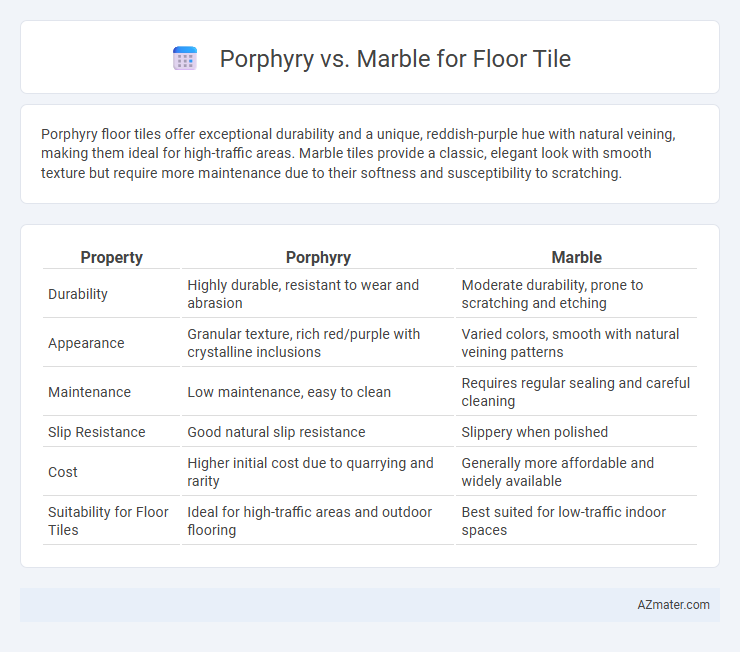Porphyry floor tiles offer exceptional durability and a unique, reddish-purple hue with natural veining, making them ideal for high-traffic areas. Marble tiles provide a classic, elegant look with smooth texture but require more maintenance due to their softness and susceptibility to scratching.
Table of Comparison
| Property | Porphyry | Marble |
|---|---|---|
| Durability | Highly durable, resistant to wear and abrasion | Moderate durability, prone to scratching and etching |
| Appearance | Granular texture, rich red/purple with crystalline inclusions | Varied colors, smooth with natural veining patterns |
| Maintenance | Low maintenance, easy to clean | Requires regular sealing and careful cleaning |
| Slip Resistance | Good natural slip resistance | Slippery when polished |
| Cost | Higher initial cost due to quarrying and rarity | Generally more affordable and widely available |
| Suitability for Floor Tiles | Ideal for high-traffic areas and outdoor flooring | Best suited for low-traffic indoor spaces |
Introduction to Porphyry and Marble Floor Tiles
Porphyry floor tiles are volcanic igneous rocks characterized by large, well-formed crystals embedded in a fine-grained matrix, offering exceptional durability and resistance to wear. Marble floor tiles, composed primarily of calcite, are renowned for their elegant veining and softer, more polished surface, making them a popular choice for luxurious interior spaces. Both materials provide distinct aesthetic and functional qualities, with porphyry suited for high-traffic areas and marble favored for its classic, refined appearance.
Geological Origins: Porphyry vs Marble
Porphyry originates from volcanic igneous rock characterized by large, durable feldspar crystals embedded in a fine-grained matrix, formed through slow cooling of magma beneath the Earth's surface. Marble is a metamorphic rock derived from the recrystallization of limestone under intense heat and pressure, resulting in a smooth, crystalline structure composed primarily of calcite. The distinct geological formations influence porphyry's hardness and textured appearance, while marble offers a softer, more polished surface with varied veining patterns.
Visual Appearance and Color Variations
Porphyry floor tiles display a distinctive, speckled texture with rich red, brown, and purple hues, creating a bold, dramatic aesthetic ideal for statement floors. Marble offers a more refined visual appearance with smooth veining patterns in a wide range of colors from classic white and beige to green, pink, and black, providing versatile elegance. Variations in marble tend to be more fluid and organic, while porphyry's color variations are more granular and uniform, catering to different interior design preferences.
Durability and Wear Resistance
Porphyry floor tiles exhibit exceptional durability and high wear resistance due to their dense, igneous rock composition, making them ideal for high-traffic areas. Marble, although aesthetically appealing with its smooth texture and veining, is softer and more prone to scratches, chips, and etching from acidic substances. For long-lasting flooring solutions, porphyry outperforms marble in maintaining structural integrity and appearance over time under heavy use.
Surface Texture and Slip Resistance
Porphyry floor tiles feature a coarse, grainy surface texture that offers excellent slip resistance, making them ideal for high-traffic or wet areas. Marble tiles have a smooth, polished surface that, while elegant, tends to be more slippery when wet and requires additional treatment or sealing for safety. The choice between porphyry and marble hinges on balancing aesthetic appeal with functional safety needs in flooring applications.
Installation Process and Techniques
Porphyry floor tiles require specialized cutting tools and experienced installers due to their hardness and dense crystalline structure, often employing diamond-tipped blades to achieve precise edges. Marble tiles, being softer and more porous, demand careful handling with standard wet saws and sealant application post-installation to prevent staining and maintain durability. Both materials necessitate a level, stable subfloor and proper adhesive selection, but porphyry's toughness extends installation time and complexity compared to the more straightforward marble tile process.
Maintenance and Cleaning Requirements
Porphyry floor tiles require minimal maintenance due to their dense, hard surface that resists stains and scratches, making them ideal for high-traffic areas. Marble tiles, while elegant, demand regular sealing and careful cleaning to prevent etching and discoloration from acidic substances. Specialized pH-neutral cleaners are recommended for marble to preserve its polished finish, whereas porphyry can withstand more robust cleaning agents without damage.
Cost Comparison: Porphyry vs Marble
Porphyry floor tiles typically cost between $10 to $25 per square foot, making them more affordable compared to marble, which ranges from $15 to $50 per square foot depending on quality and origin. Maintenance expenses for porphyry are generally lower due to its durability and resistance to stains, whereas marble requires frequent sealing and careful upkeep to prevent etching and discoloration. Budget-conscious homeowners often prefer porphyry for its cost-effectiveness and long-term value in flooring projects.
Environmental Impact and Sustainability
Porphyry floor tiles offer superior environmental benefits due to their natural durability and low maintenance requirements, resulting in less frequent replacement and reduced resource consumption over time. Marble, while aesthetically appealing, typically undergoes more intensive quarrying and processing, which increases its carbon footprint and environmental degradation risks. Choosing porphyry enhances sustainability by minimizing waste and energy use throughout the tile's lifecycle, promoting eco-friendly flooring solutions.
Best Applications and Design Recommendations
Porphyry floor tiles offer exceptional durability and slip resistance, making them ideal for high-traffic commercial spaces and outdoor areas where toughness and safety are paramount. Marble tiles, with their elegant veining and polished finish, are best suited for luxurious indoor settings such as bathrooms, entryways, and living rooms where aesthetic appeal and smooth texture are desired. For design recommendations, combine porphyry in rugged industrial or rustic styles, while marble complements classic, contemporary, or minimalist interiors with its timeless sophistication.

Infographic: Porphyry vs Marble for Floor Tile
 azmater.com
azmater.com